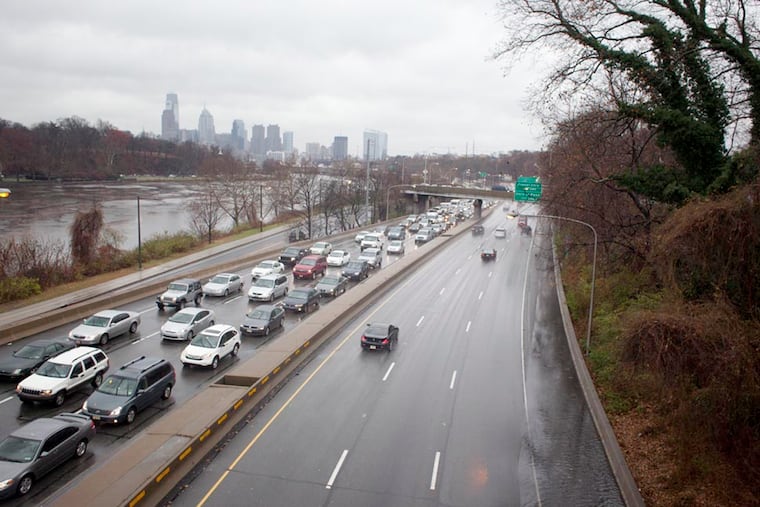Experts: Opening Schuylkill Expressway's shoulders to traffic has potential
Traffic jams and sudden stops are routine miseries for tens of thousands commuting each day on the Schuylkill Expressway.

Traffic jams and sudden stops are routine miseries for tens of thousands commuting each day on the Schuylkill Expressway.
The traffic is so bad that the intersection with Route 1 made a 2015 list of America's 50 worst bottlenecks from American Highway Users Alliance and AAA.
Pennsylvania's Department of Transportation is studying fixes to the 1950s-era road. A key option is opening the shoulders to traffic during peak hours between Route 202 and Route 1, where the road narrows to two lanes in each direction. Experts say the proposal could add capacity without major spending.
"It's much more efficient to try to milk the existing system for all you can," said Keith Hartington, senior transportation planner at the Delaware Valley Regional Planning Commission.
Hartington is participating in the PennDot study by conducting models on how "hard shoulders" on the expressway would work, he said, an evaluation that should be complete in the spring or summer.
It is not certain that hard shoulders will be deemed feasible. If they are, it is unclear what the conversion would cost or when it might happen.
The possibility of relieving congestion on the expressway by opening the shoulders has been explored before, because the expressway's geography, with cliffs on one side and a steep drop into the river on the other, makes expansion difficult, officials said.
Another option, building a deck above the existing highway, would be pricey.
"If the alternative is decking on I-76, this is a way better proposal," said Nick Klein, a professor at Temple University's department of community and regional planning. "Alternatively, we may hope as part of their study they're looking at other ways to manage demand."
He called the idea a "pragmatic" but temporary solution. Expanding a road usually attracts drivers who fill the new space, said Klein, who disclosed that he had applied for, but not received, research grants from PennDot.
Concern about attracting additional drivers is one of the reasons the shoulders would be opened only during peak travel hours, typically from 6 a.m. to 9:30 a.m. and 4 to 8 p.m.
"It's just a temporary congestion release," Hartington said. "We're not looking at widening the Schuylkill."
Michael Noda, a local transportation activist who runs the blog Sic Transit Philadelphia, also said drivers would flock to the road if they thought it would be less busy, and he worried that opening the shoulders would rob first responders of a clear path to accidents.
"When there's a problem on the Schuylkill, those shoulders serve an important purpose," Noda said.
He called the plan to open the shoulders to traffic "counterproductive" and argued that public transportation was the best salve for traffic jams.
Breakdown areas could be added, Hartington said, and the hard shoulders would be complemented by sophisticated cameras, signs and control systems that could quickly close shoulders to traffic if they were needed by emergency vehicles.
If the hard shoulders became a reality, experts and officials said, upgrades would likely be needed to the access ramps and the shoulders' paving, which might need to be sturdy enough to handle regular truck traffic.
"The trucks are what abuse the roads," said Joseph Martin, a Drexel University civil-engineering professor.
Compared with some alternatives, though, opening the shoulders is "fairly inexpensive," he said.
Other issues the models will look at are whether opening the shoulders in one place would create bottlenecks elsewhere, and the extent to which pillars supporting area bridges could block traffic on a shoulder, Hartington said.
Technology also could be a key to making the road safer, from signs that advise drivers of slow traffic ahead or list train schedules to divert motorists to public transit.
"It makes the system operate better when drivers have better information," Hartington said.
215-854-4587
@jasmlaughlin